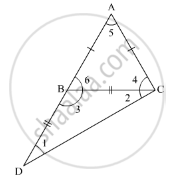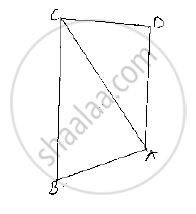Advertisements
Advertisements
Question
In a triangle ABC, if AB = AC and AB is produced to D such that BD = BC, find ∠ACD: ∠ADC.
Solution
In the given ΔABC,AB = ACand AB is produced to D such that BD = BC
We need to find ∠ACD : ∠ADC

Now, using the property, “angles opposite to equal sides are equal”
As AB = AC
∠6 = ∠4 ........(1)
Similarly,
As BD = BC
∠1 = ∠2 ........(2)
Also, using the property, “an exterior angle of the triangle is equal to the sum of the two opposite interior angle”
In ΔBDC
ext. ∠6 = ∠1 + ∠2
ext. ∠6 = ∠1 + ∠1 (Using 2)
ext. ∠6 = 2∠1
From (1), we get
ext. ∠4 = ∠2 .......(3)
Now, we need to find ∠ACD : ∠ADC
That is,
(∠4 + ∠2): ∠1
(2∠1 + ∠2) : ∠1 (Using 3)
(2∠1 + ∠1) : ∠1(Using 2)
3∠1 :∠1
Eliminating ∠1from both the sides, we get 3:1
Thus, the ratio of ∠ACD :∠ADC is 3 :1
APPEARS IN
RELATED QUESTIONS
Determine the measure of each of the equal angles of a right-angled isosceles triangle.
ABC is a triangle in which BE and CF are, respectively, the perpendiculars to the sides AC and AB. If BE = CF, prove that ΔABC is isosceles
Which of the following statements are true (T) and which are false (F):
If the bisector of the vertical angle of a triangle bisects the base, then the triangle may be isosceles.
In Fig. 10.131, prove that: (i) CD + DA + AB + BC > 2AC (ii) CD + DA + AB > BC

Which of the following statements are true (T) and which are false (F)?
Sum of the three sides of a triangle is less than the sum of its three altitudes.
Write the sum of the angles of an obtuse triangle.
If the angles of a triangle are in the ratio 2 : 1 : 3, then find the measure of smallest angle.
In ΔABC, if ∠A = 100°, AD bisects ∠A and AD ⊥ BC. Then, ∠B =
In a ΔABC, ∠A = 50° and BC is produced to a point D. If the bisectors of ∠ABC and ∠ACDmeet at E, then ∠E =
Show that in a quadrilateral ABCD, AB + BC + CD + DA < 2(BD + AC)
